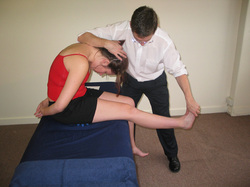
The Response to the Slump Test in a Group of Female Whiplash Patients
Yeung E, Jones M, Hall B 1997 The response to the slump test in a group of female whiplash patients. Australian Journal Physiotherapy (4):245-252
ABSTRACT
This study was undertaken to assess the difference between the response to the slump test in 40 asymptomatic and 20 symptomatic female subjects with cervical pain after whiplash injury. Areas and alterations of pain responses during the test, and ranges of movement of knee extension, were analysed. The results demonstrated that the addition of knee extension and left ankle dorsiflexion during the slump test produced a significant increase in the intensity of comparable cervical symptoms in the whiplash group. The whiplash group also showed a greater limitation in knee extension range of movement during the test than did the control group. These differences suggest that pathological changes of the neural system itself or adjacent tissues, affecting the mechanics of the neural system, may be a contributing factor to these patients' cervical symptoms.
Commentary
This suggests that there may be a neurodynamic component to some whiplash associated disorders which means that physical examination of the slump test might be an integral part of diagnosis and management of some whiplash patients.
Also, the test may be a useful means of excluding neurodynamics if the response is normal.
Download Free PDF from Australian Physiotherapy Association web site.
Yeung E, Jones M, Hall B 1997 The response to the slump test in a group of female whiplash patients. Australian Journal Physiotherapy (4):245-252
ABSTRACT
This study was undertaken to assess the difference between the response to the slump test in 40 asymptomatic and 20 symptomatic female subjects with cervical pain after whiplash injury. Areas and alterations of pain responses during the test, and ranges of movement of knee extension, were analysed. The results demonstrated that the addition of knee extension and left ankle dorsiflexion during the slump test produced a significant increase in the intensity of comparable cervical symptoms in the whiplash group. The whiplash group also showed a greater limitation in knee extension range of movement during the test than did the control group. These differences suggest that pathological changes of the neural system itself or adjacent tissues, affecting the mechanics of the neural system, may be a contributing factor to these patients' cervical symptoms.
Commentary
This suggests that there may be a neurodynamic component to some whiplash associated disorders which means that physical examination of the slump test might be an integral part of diagnosis and management of some whiplash patients.
Also, the test may be a useful means of excluding neurodynamics if the response is normal.
Download Free PDF from Australian Physiotherapy Association web site.
